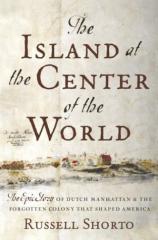The Island at the Center of the World
Review
The Island at the Center of the World
The jacket copy for this fascinating book nowhere describes author
Russell Shorto as a professional historian. True, he has written
two other books on subjects dealing with the past (the historical
Jesus and the relationship of psychiatry to religion), but his
blurb writers conspicuously avoid the "H" word.
Just as well. He writes sprightly, almost novelistic prose --- and
he is indeed a man with a mission: He wants to destroy the common
conceptions (misconceptions, he calls them) that English influence
was the only force that brought New York City into being and that
the nearly 40-year existence of the New Netherland colony was
merely an unimportant preliminary throat-clearing before the "real
story" began with the English takeover in 1664. He goes about this
worthy task with missionary zeal and literary zest.
His main historical source is a huge mass of documents from the New
Netherland period now being translated in an obscure office in the
New York State Library by historian and linguistic scholar Charles
Gehring, to whom he give full credit. But he has also unearthed all
sorts of fascinating documents, both historical gems and delightful
trivia, in England, in the Netherlands, all over the USA and in
various odd venues on the European continent.
The names that every school kid knows from that era -- Peter Minuit
and Peter Stuyvesant -- are duly present; Stuyvesant, of course is
a major player in the drama. But to them Shorto has added at least
two others -- Adriaen Van der Donck, a young Dutch lawyer who
fought long and hard to moderate Stuyvesant's rigidity and
intolerance in favor of a more liberal philosophy of government,
and Willem Klieft, a bullheaded bureaucrat whose foolish pugnacity
nearly ruined the whole enterprise. All four of these men, and a
fascinating cast of lesser players, are drawn in the round with
novelistic verve. If you think "history" is a synonym for "dull,"
this book will change your mind. There are occasional patches of
needlessly purple prose and hyperbole, but they are easily
negotiated.
Shorto places the founding of the colony firmly in the historical
context of the military and mercantile rivalries among England,
Holland and Spain. New York's "father city" was not London but
Amsterdam, he argues, and his evidence is convincing. (The vast
colony was New Netherland; the island city was New Amsterdam). It
is more than a matter of surviving Dutch street names and family
names in the region; it involves a basic philosophy of religious
and racial toleration, a system of representative government and a
spirit of inquiry and adventure that survive in the city
today.
The original New Netherland colony, founded in 1625, took in
everything from present-day Delaware to Connecticut. Manhattan
Island was the nerve center because of its stretegic position on a
fine harbor and a broad river that led north into the interior of
the unexplored continent. The true hero of Shorto's tale is Van der
Donck, a man now so utterly forgotten that even the single portrait
of him that survives may not even be him at all. Shorto makes him
out a gutsy battler for justice and tolerance and a careful
recorder of every detail he could find about the wild new land he
came to love.
Indians, of course, are a major presence in this story, and Shorto
is careful to do them justice. You can almost hear him cheering
when Willem Klieft, who stirred up a needless and bloody war
against them, is shipwrecked and drowned.
There are all sorts of delightful asides, digressions and details
in this book (did you know that the classic log cabin of the
American frontier seems to have originated with Finnish craftsmen
imported into the Swedish-settled southern regions of New
Netherland?). It is hard, when you think of the great metropolis of
asphalt and steel that is Manhattan Island today, to imagine it as
a wilderness with clear streams, a few Indian paths and dense
vegetation, which is what it was during its New Amsterdam period
(1625-1664) --- but Shorto has done a splendid job of imagining it
for us. If that describes the historian's job, then Shorto is a
first-rate historian, no matter what the jacket copy says.
Reviewed by Robert Finn (Robertfinn@aol.com) on January 24, 2011
The Island at the Center of the World
- Publication Date: March 16, 2004
- Genres: History, Nonfiction
- Hardcover: 384 pages
- Publisher: Doubleday
- ISBN-10: 0385503490
- ISBN-13: 9780385503495





